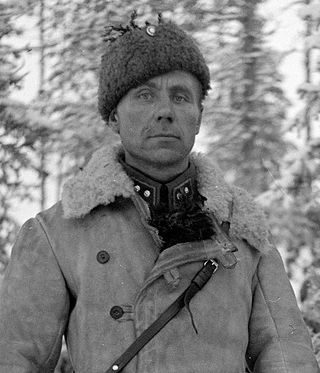
The Finnish Defence Forces (FDF) (Finnish: Puolustusvoimat, Swedish: Försvarsmakten) are the military of Finland. The Finnish Defence Forces consist of the Finnish Army, the Finnish Navy and the Finnish Air Force. In wartime the Finnish Border Guard (which is its own military unit in peacetime) becomes part of the Finnish Defence Forces.
A private is a soldier, usually with the lowest rank in many armies. Soldiers with the rank of private may be conscripts or they may be professional (career) soldiers.

Military ranks are a system of hierarchical relationships, within armed forces, police, intelligence agencies or other institutions organized along military lines. The military rank system defines dominance, authority, and responsibility in a military hierarchy. It incorporates the principles of exercising power and authority into the military chain of command—the succession of commanders superior to subordinates through which command is exercised. The military chain of command constructs an important component for organized collective action.

Lauri Allan Törni, later known as Larry Alan Thorne, was a Finnish-born soldier who fought under three flags: as a Finnish Army officer in the Winter War and the Continuation War ultimately gaining a rank of captain; as a Waffen-SS captain of the Finnish Volunteer Battalion of the Waffen-SS when he fought the Red Army on the Eastern Front in World War II; and as a United States Army Major when he served in the U.S. Army Special Forces in the Vietnam War.
Major is a military rank of commissioned officer status, with corresponding ranks existing in many armed forces throughout the world. When used unhyphenated and in conjunction with no other indicators, major is one rank above captain in armies and air forces, and one rank below lieutenant colonel. It is considered the most junior of the field officer ranks.

The Reserve Officer School, located in Hamina, Finland, near the southeastern border, is responsible for the training of most Finnish reserve officers.
Feldwebel is a non-commissioned officer (NCO) rank in several countries. The rank originated in Germany, and is also used in Switzerland, Finland, Sweden, and Estonia. The rank has also been used in Russia, Austria-Hungary, occupied Serbia and Bulgaria.
The Military ranks of Finland are the military insignia used by the Finnish Defence Forces. The ranks incorporates features from Swedish, German, and Russian armed forces. In addition, the system has some typically Finnish characteristics that are mostly due to the personnel structure of the Finnish Defence Forces. The ranks have official names in Finnish and Swedish languages and official English translations. The Swedish forms are used in all Swedish-languages communications in Finland, e.g. in Swedish-speaking units of Finnish Defence Force. The system of ranks in the Swedish Armed Forces is slightly different.

Sergeant is a Swedish (OR6) and Finnish (OR5) military rank above överfurir in Sweden and alikersantti in Finland; and below översergeant in Sweden and ylikersantti in Finland.

The army rank of captain is a commissioned officer rank historically corresponding to the command of a company of soldiers. The rank is also used by some air forces and marine forces, but usually refers to a more senior officer. Today, a captain is typically either the commander or second-in-command of a company or artillery battery. In the Chinese People's Liberation Army, a captain may also command a company, or be the second-in-command of a battalion.
Senior lieutenant is a military grade between a lieutenant and a captain, often used by countries from the former Eastern Bloc. It is comparable to first lieutenant.

Conscription in Finland is part of a general compulsion for national military service for all adult males defined in the section 127 of the Constitution of Finland.
Vääpeli is a Finnish and former Swedish non-commissioned officer military rank above ylikersantti and below ylivääpeli. The rank is derived from the German rank Feldwebel and was used as a rank in the Landsknecht for the one who was responsible for aligning troops during battle.
Vänrikki, from the German fähnrich, is a Finnish commissioned officer rank (OF1). A typical assignment for a professional vänrikki is as junior instructor of recruits.
Majuri (Major) is a military officer's rank (OF3) in Finland, senior to Kapteeni and junior to Everstiluutnantti.
Maanpuolustusopisto was the military junior college of the Finnish Defence Forces, located in Lappeenranta. The school had a separate program for training officers "vocationally" such that they would graduate as Second Lieutenants (vänrikki), without going to the national military academy, Cadet School. The school was decommissioned in 2001 and repurposed as the Army Academy to provide training for the Finnish National Defence University.
Eero Johannes Naapuri was a Finnish Colonel and skier.

Seinäjoen Jalkapallokerho is a Finnish professional football club from the city of Seinäjoki. The club plays in the Veikkausliiga, the highest tier of the Finnish league system. Their home ground is OmaSP Stadion, which is located near the city center and next to SJK's training facility Wallsport. SJK was formed in 2007 after the merger of TP-Seinäjoki and Sepsi-78.
Captain is a title, an appellative for the commanding officer of a military unit; the supreme leader of a navy ship, merchant ship, aeroplane, spacecraft, or other vessel; or the commander of a port, fire or police department, election precinct, etc. In militaries, the captain is typically at the level of an officer commanding a company or battalion of infantry, a ship, or a battery of artillery, or another distinct unit. The term also may be used as an informal or honorary title for persons in similar commanding roles.

Ilmari Turja was a Finnish writer, best known as a journalist and playwright, with a career spanning nearly eight decades from the 1920s to the 1990s.









